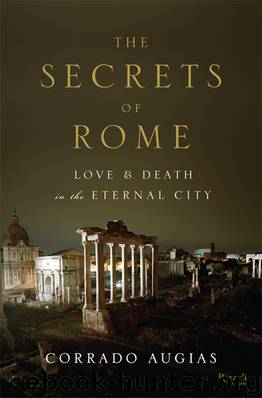The Secrets of Rome by Corrado Augias

Author:Corrado Augias [Augias, Corrado]
Language: eng
Format: epub
ISBN: 978-0-8478-4277-3
Publisher: Rizzoli
Published: 2014-03-31T16:00:00+00:00
1. Federico Fellini, Intervista (New York: Castle Hill Productions, Inc., 1992), film. The quote paraphrased here is from the Italian; Castle Hill Productions, Inc. distributed a version with English subtitles in the United States.
VIII
TOWERS OF FEAR
THE APPROACH TO THE CHURCH of the Santi Quattro Coronati (Four Crowned Saints) ascends from below, along the Via dei Querceti. As soon as you turn left at the corner of the Via dei Santi Quattro a gigantic fortress appears; powerful, ancient walls rise before you, inspiring the immediate impression that you’re standing before something truly exceptional—and that’s precisely what this out-of-the-way, little-known corner of Rome, the church of the Santi Quattro, is. According to one legend the four saints were legionaries (with the names of Severus, Severianus, Carpoforus, and Vittorinus) who were martyred because they refused to worship the statue of a false god. Yet another legend says they were four Dalmatian artists killed by Diocletian because they refused to sculpt that same statue. Their remains, whoever they may have been, are buried in a crypt of the church. What really counts is the building itself, a fundamental testament of the distant past, laden with messages and news, much like a time capsule.
The church was first built in the fourth century, and was constructed on the foundations of a pre-existing Roman building, as was typical of that era. The earlier structure must have been usually impressive, given the size of the surviving vaulted apse, which is enormous when compared to the rest of the building. The original church was much larger, as can easily be seen by the partially walled-in columns between the nave and side aisles. After Robert of Guiscard’s Norman troops sacked the city in 1084 Santi Quattro Coronati was rebuilt, and today all that remains of the first church is its apse. There is a semicircular crypt under the high altar, and the reliquaries of the martyred saints so venerated by the pilgrims were placed at its center. From the left aisle of the church a door opens (after ringing a bell) onto a beautifully decorated cloister with a twelfth-century fountain at its center for ritual ablutions, a portico of paired colonnettes, and capitals decorated with aquatic foliage. Recent excavations revealed an underground passage that connects this fortified basilica with the cathedral church of Saint John Lateran. This tunnel was an escape route for popes who would have found a secure refuge at Santi Quattro Coronati if they needed it. All of the many magnificent columns here, with both smooth and fluted shafts, obviously came from older temples and other Roman buildings. There are two courtyards in front of the church, and the second was originally part of the first basilica. The impressive tower dates to the ninth century, and served the purpose of both observation platform and defensive keep.
This brief description provides a basic idea of the church complex and its buildings, but much more can be said about their frescoes, decorations, and furnishings. The most striking aspect of Santi
Download
This site does not store any files on its server. We only index and link to content provided by other sites. Please contact the content providers to delete copyright contents if any and email us, we'll remove relevant links or contents immediately.
Spell It Out by David Crystal(35852)
Underground: A Human History of the Worlds Beneath Our Feet by Will Hunt(11844)
A Year in the Merde by Stephen Clarke(5080)
Venice by Jan Morris(2436)
Claridge's: The Cookbook by Nail Martyn & Erickson Meredith(2260)
My Paris Kitchen: Recipes and Stories by Lebovitz David(2135)
A TIME OF GIFTS by Patrick Leigh Fermor(2103)
The Plantagenets by Dan Jones(1935)
Welcome to the Goddamn Ice Cube by Blair Braverman(1888)
Bang Poland: How To Make Love With Polish Girls In Poland by Roosh V(1862)
Top 10 Prague (EYEWITNESS TOP 10 TRAVEL GUIDES) by DK(1852)
The Finnish Way by Katja Pantzar(1811)
The Isle of Mull by Terry Marsh(1807)
From Russia with Lunch by David Smiedt(1798)
A TIME TO KEEP SILENCE by Patrick Leigh Fermor(1775)
Rick Steves London 2018 by Rick Steves & Gene Openshaw(1752)
A Taste of Paris by David Downie(1747)
Merde in Europe by Stephen Clarke(1672)
Insight Guides Experience Tokyo by Insight Guides(1660)
